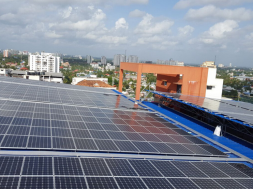
NEW YORK: The wind and solar industries hope demand for carbon-free power from U.S. cities, states and corporations can offset headwinds from President Donald Trump’s tax policy and tariffs, developers said this week.
The Trump tax overhaul trimmed production and investment tax credits, and the administration also slapped a 30 percent tariff on imported solar panels. The moves, aimed at boosting manufacturing and economic growth, also dimmed prospects for renewables.
But Trump’s withdrawal of federal support for Obama-era climate goals indirectly helped the industry by inspiring a backlash among U.S. cities, states and corporations, which have grown more ambitious about installing cleaner forms of energy.
Also, investors with years of deals under their belts are less wary about financing solar and wind than they were years ago, and socially responsible funds are actively seeking projects to invest in, according to executives and investors at the Renewable Energy Finance Forum-Wall Street in New York.
Gregory Wetstone, president and chief executive officer of the American Council on Renewable Energy, noted that two big solar projects worth about $2.5 billion total have been canceled or stalled since the tariffs were announced in January. The Solar Energy Industries Association has said the tariffs would result in the loss of 23,000 U.S. jobs.
But some manufacturers and developers have announced new projects in the face of the tariffs. Wetstone noted that solar led all generation sources with 2.5 gigawatts of new capacity in the first quarter of 2018.
‘SEA CHANGE’ IN DEMAND
“There is a sea change in grass-roots demand for renewable energy,” Susan Nickey, managing director at Hannon Armstrong Sustainable Infrastructure Capital Inc (HASI.N), which invests about $1 billion a year in the sector, said in an interview on the sidelines of the conference on Tuesday.
“More and more corporations and consumers are saying ‘We want 100 percent renewable energy,’” she said, adding city and state governments are adopting renewable-friendly policies to reflect that growing demand.
She cited a survey of financial institutions that showed two-thirds of respondents planned to boost renewable investments this year. Some 89 percent said they would sharply increase planned investments from now to 2030 unless government policies slow demand for renewable energy. (bit.ly/2lsBoRI)
Craig Cornelius, president of NRG Energy Inc’s (NRG.N) NRG Renewables, told a panel at the conference that while Trump’s tax bill was initially worrying, “it has been ultimately easier to work through the repercussions than we anticipated.”
As the bill moved through Congress, Republican lawmakers from states with renewable projects joined Democrats to make changes. The final version kept 80 percent of the investment tax credit and production tax credit values, and dropped a proposed corporate alternative minimum tax that would have made the tax credits less valuable.
“Members on both sides of the aisle stepped out to support us,” Laura Beane, president and chief executive officer of Avangrid Renewables, said on Wednesday. Avangrid is developing the 800-megawatt Vineyard Wind project off the coast of Massachusetts.
DODGING TARIFFS
Quick action helped many developers dodge harm from U.S. tariffs on solar cells, noted Stacey Kusters, president of Berkshire Hathaway Energy Co’s [MEHC.UL] BHE Solar.
“A lot of the projects that were planned went in and bought two years’ worth of panels” before the tariffs, she said.
Meanwhile, the industry is bracing for the scheduled reduction and ultimate expiry of lucrative subsidies on solar and wind power over the coming years, including a 30 percent tax credit on solar installations.
This will make it trickier to finance some renewable projects, said Robert Sternthal, managing director at Rubicon Capital Advisors, who is putting together a team of bankers to advise on renewable deals in North America.
Without the incentives, “pricing may have to go up on the electricity side” for some projects, he said on Tuesday. Yet he also expects growing demand from tech corporations that have pledged to be carbon-neutral and will not rely on wind or solar energy for profits.
“Google, Facebook and Apple don’t have to make 6 to 7 percent returns on these assets,” he said.
Improvements in technology could help make wind and solar more competitive “in terms of cost and sustainability” after tax credits expire, said Rafael Gonzalez, president and chief executive officer of Enel Green Power North America, whose projects include wind, solar, geothermal, and hydropower.
Beane said Avangrid Renewables is betting on prospects for “a lot of demand for offshore wind power in the U.S. Northeast.” The company starts construction on the Vineyard Wind project next year, and it is slated to come online in 2021.

By then, she said, the project may be competitive on its own thanks to improved technology and expertise: “You’ll be very surprised at the prices.”
















